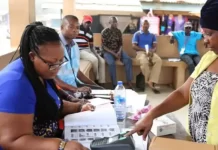
As a customer, I have learnt a lot of lessons about problems associated with ECG prepaid meters, which I feel obliged to share with your readers, especially following a recent Joy FM discussion between Kojo Yankson, as host of the programme, and an official of the ECG on issues surrounding ECG prepaid meters. It was a very informative discussion though, except that the line of questioning by the host, the kind of responses from the ECG official, coupled with a contribution by an official of the Ghana Standards Authority must have left many among the listeners rather confused.
In a subsequent programme, an academic and a consumer protection advocate joined an official of ECG to deliberate further on the issue, especially that of faulty meters. The discussion was very illuminating and pointed at some actions ECG must take to address this whole confusion about prepaid meters in particular and the billing system of ECG in general.
The central issue here is the usual complaint, supposedly by many, of an alleged phenomenon of “vanishing” current. As narrated by the host, one buys “current” worth GHS50.00 which lasts for one week, then buys a further GHS50.00 “current” but this time lasts less than a week as before. In attempting to explain using the tariff band system in operation, the discussion strayed into why a prepaid customer should ever owe ECG. The ECG official explained that it results from faults which develop such that prepaid meters fail to trip to cut service when the customer exhausts the amount of current last purchased. Here, the host vehemently disagreed that the customer should ever owe on his or her prepaid meter because the fault is that of ECG and not the customer.
The number one problem of most residential prepaid meter consumers is that they are unable to estimate how much they consume in a month and so tend to buy on incremental basis. So when one buys at increments of say, GHS50.00, then one expects each incremental purchase to have the same lifespan. The answer is no. Unfortunately, ECG has not been able to explain this to the understanding of the majority. As consequence, ECG will continue to suffer a bad image. The only way to overcome this is to step up public education on how it bills consumers.
ECG is mandated to charge tariffs on residential consumption of electricity using four or so different band rates; the bands are 0-50, 51-300, 301-600, and 601+ or above. The lowest tariff is for consumption in the first band 0-50, and the rate goes up when your consumption falls within 51-300, higher again if it falls within 301-601, and highest if it exceeds 601 units. To understand the tariff bands, it is also necessary to point out that the tariff increases announced only give the average, so that the actual increase may be less at the 0-50 band and higher and higher as one climbs the tariff bands.
For instance, if your consumption is 72 units, you would pay the first 50 units at the lowest tariff and the remaining 22 units will be charged at a higher tariff. For consumption amounting to 320 units, the first 50 units will be charged at the lowest tariff, the next 250 units will be charged using the tariff for the second band, and the remaining 20 units will be charged using the tariff for the third band. Finally, for consumption up to 640 units, the consumer will pay 50 units at the lowest tariff, the next 250 units at the tariff for the second band, another 300 units at the tariff for the third band, and the last 40 units at the tariff for the 601+ band. The tariffs increase steeply from the first band 0-50 to the second, third and fourth bands. Those with credit meters can easily see this on their bills, but not consumers on prepaid meters.
To help residential customers understand the billing system, ECG has an easy reckoner on its website. According to this reckoner, the bills consumers pay include the energy charge for the units they consume, in addition to levies for street lights, national electrification, and a service charge depending on their respective levels of consumption, less Government subsidy and utility relief they enjoy, also depending on their total consumption. The subsidy ends at 150 units, while the utility relief ends at 300 units. Combining all these factors, you pay a net charge of GHS17.66 for the first 50 units, GHS216.85 at 300 units, and GHS516.88 at 600 units. The net charge increases astronomically according to your consumption.
The same principle goes for the prepaid meters. So for instance, for a net charge of GHS52.57, you are supposed to enjoy 70 units of electricity. This means that this is made up of GHS17.66 for the first 50 units and an additional GHS34.91 for the next 20 units. So when you go to the vendor and buy GHS50.00 worth of electricity current, you would be charged using tariffs for the first band and the second band. You have crossed bands. When this is exhausted and you buy an additional GHS50.00, the meter will recognize that you have crossed the first 50 units into the second band and so charge according to the second tariff or even higher. The implication is that the second GHS50.00 will give you less units than what the first GHS50.00 entailed. So whether you get less or not from your incremental purchases will depend whether you are still within a tariff band or you are exceeding a specific tariff band.
To see the real performance of your electricity meter, it is better to estimate how much worth of electricity current you need to cover a whole month. The same tariff band principle applies, but monthly purchases will help to detect early whether your meter is malfunctioning or not.
Another issue is that, technically, a prepaid meter is supposed to trip and cut off service when you exhaust your “credit”, as we say. There are instances where the meter rather trips to “Error 1” and continually makes a beeping sound but does not cut off electricity service to your house or room. The meter has both an electronic and a manual mode of reading. The electronic reader is visible to the consumer, but the manual reader is embedded in the meter. When the meter trips to ‘Error 1”, it does not cut off the service, so the consumer continues to enjoy service. However, the manual reader continues to work, recording the unit consumed as if it is a credit meter, rather than a prepaid meter.
The prepaid meter is an electronic and electrical gadget like your TV set, etc., and so can become faulty. When your TV set develops a fault, though it cannot transmit your DSTV service, it does not absolve you from payment of your DSTV subscription. So when the prepaid electricity meter develops a fault which does not cut off your service but allows you to continue to enjoy electricity service, ECG can easily determine your indebtedness from the manual reader in the meter and charge you the amount.
Contrary to the argument of Mr. Kojo Yankson, customer service does not imply the consumer is not liable to pay. ECG may on humanitarian grounds decide so anyway. But if ECG decides to collect the debt, the customer service about it is whether ECG will disconnect the service and demand full payment before reconnection. It will amount to bad customer service. The appropriate customer service is to arrange a terms of payment convenient to both parties and allow the customer to continue to enjoy the service subject to the agreed terms.
The danger in the stance of Mr. Kojo Yankson is that, an unscrupulous customer will not report that the meter is faulty and enjoy “free service” forever. Even some customers will find ways and means to tamper with their meters in order to enjoy the “free service.” It is for such reasons that the meters have both electronic and manual reading modes.
























